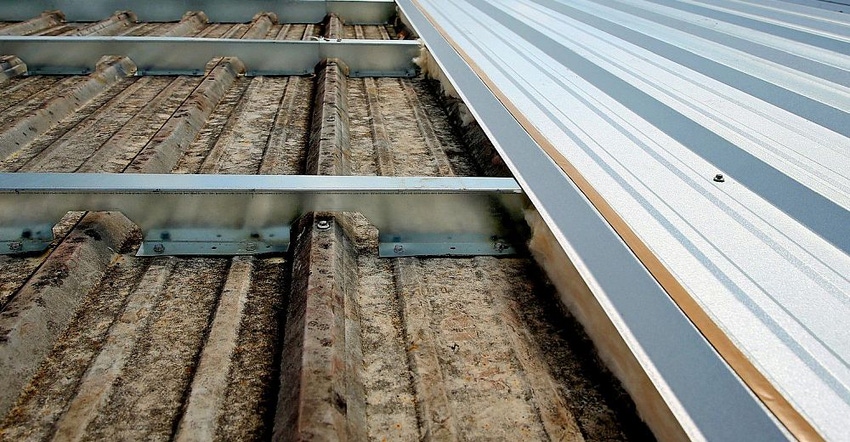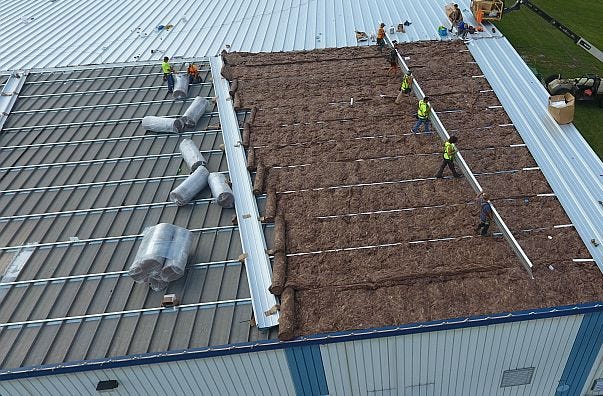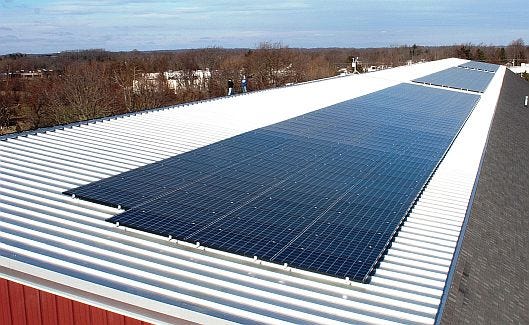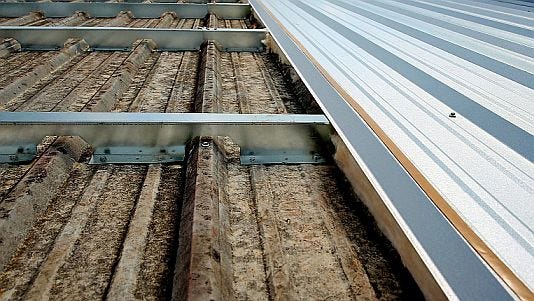If your self-storage roof looks shabby and functions poorly, it’s time for action. But rather than remove and replace the old structure, consider a retrofit, which allows new metal to be installed over the old. Here are the primary benefits and considerations for this approach.

When faced with an old metal roof that no longer looks or functions as it should, most self-storage owners will naturally think they need to remove the existing roof and install a new one in its place. But doing so would mean exposing the building’s contents to the elements. It would also require security for those exposed storage units. Thankfully, there’s a simpler, safer way of getting the job done without disrupting daily operation.
Retrofitting is an excellent alternative to roof replacement. Structural steel sub-framing members are installed on top of the existing roof, fastened through to the building. The members are designed so the new roof can meet all current wind- and snow-load code requirements, and there are a plethora of other benefits. Let’s look at what they are and some important factors to consider.
Time to Make Upgrades!
A retrofit provides the perfect opportunity to make key improvements to your self-storage roof system. First, you’ll have the chance to upgrade an older screw-down or through-fastened metal roof to the newer standing-seam type that’ll have few if any exposed fasteners. This is an option you don’t have if you remove the existing roof without making significant structural modifications to the framing.

Workers creating airspace between the old and new roof
Retrofitting also creates an airspace between the old and new roof structure, which is an opportunity to add insulation for energy efficiency. Sub-framing systems can be designed for different heights to reach greater R-values, enabling a self-storage owner to turn a traditional storage building into a climate-controlled structure.
The airspace can also be used to create a dynamic, convective ventilation system for non-climate-controlled buildings. This is what they call “above sheathing ventilation.” Basically, it takes the heated air beneath the new metal roof and ventilates it through the ridge of the building. The benefit is the roof becomes a radiant barrier that reduces heat transfer through its assembly by as much as 45%. This system can be integrated with new insulation as well.
Finally, once the retrofit is complete, consider adding photovoltaic solar panels. With the use of specialty attachment clamps, these panels can be secured to the new roof without any penetrations, and standing-seam metal roofs make an excellent platform. In fact, they’re the only roof system with a longer lifespan than the solar panels themselves!
Solar-panel systems have declined in price to where they’re much more affordable. Plus, there are many incentives to offset the costs. They can supply your self-storage building with all or most of the electricity it needs. You might even be able to sell the excess to the energy company and generate revenue for your business!

Solar panels on a standing-seam metal roof
Other Benefits of Retrofitting
Long lifespan, low lifetime cost. Metal roofs require very little maintenance and outlast roofs made of any other material. Because they have the best lifespan, they also have the lowest lifetime cost. Several metal-roof products have finish warranties of up to 40 years. New Galvalume, standing-seam roofs have a service life of 60-plus years! This is roughly three times the life of the nearest competitive product. When you invest in a retrofit, it’s comforting to know the roof will perform properly for decades to come.
Code compliance. By using a fully engineered retrofit sub-framing system, the new self-storage roof will meet today’s strict wind-uplift and snow-load requirements. It’ll be designed to reinforce to the roof zones most affected by Mother Nature.
Insurance benefits. More insurance underwriters want to know the self-storage property they cover complies with current building codes. A retrofit system will demonstrate your conformity.
Federal tax credits. Putting a new roof on a commercial building is a large expense that usually requires planning and budgeting; however, changes in the tax law allow owners to expense a new commercial roof in a single year, making it less of a financial burden. The Tax Cuts and Jobs Act of 2017 allows self-storage owners to deduct the full costs of a roof replacement up to $1 million in the year it’s completed. If your facility needs a new roof, the one-time deduction might make it more affordable. Check with your tax professional for advice.

Retrofit framing over an existing roof
Find a Specialist
Before you proceed with a self-storage roof retrofit, find a contractor who specializes in roofing for metal buildings. The typical roofer might be skilled with shingles, or built-up or single-ply systems, but metal roofs are totally different. I suggest you call your building manufacturer for a recommendation, as it’ll have a network of builders and installers. If the roof is repairable, this’ll protect any remaining warranty you may have. (Be careful to not inadvertently void your warranty with an improper patch or coating.)
A metal roof is a top-of-the-line system, but you need an experienced company to guide you. Ask any provider you consider for your retrofit how it intends to do the work and request references.
Before starting a roof replacement, consider the many benefits a retrofit can provide. I’ve given you lots to consider! Just one final thought: By employing integrated retrofit technologies, there are several ways in which your project can pay for itself, and what self-storage owner doesn’t like that?
Dale Nelson is president of Roof Hugger LLC, a Tampa, Florida-based manufacturer of retrofit framing systems for existing metal roofs. Dale holds contractor and real estate broker licenses in Florida. He’s been in general contracting since 1973, constructing commercial and industrial buildings of all construction types including wood column and beam, masonry, formed and poured, tilt-wall, and pre-engineered steel buildings. For more information, call 800.771.1711.
About the Author(s)
You May Also Like





